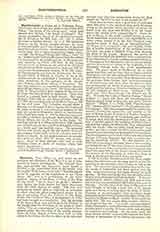

Elevation, the.—What we now know as par excellence the Elevation of the Mass is a rite of comparatively recent introduction. The Oriental liturgies, and notably the Byzantine, have indeed a showing of the consecrated Host to the people, with the words “Holy things to the holy”, but this should rather be regarded as the counterpart of our “Ecce Agnus Dei” and as a preliminary to the Communion. Again, in the West, a lifting of the Host at the words “omnis honor et gloria”, immediately before the Pater Noster, has taken place ever since the ninth century or earlier. This may very probably be looked upon as originally an invitation to adore when the great consecratory prayer of the canon extending from the Preface to the Pater Noster (see Cabrol in “Dict. d’Archeologie”, I, 1558) had been brought to a conclusion. But the showing of the Sacred Tlost (and still more of the Chalice) to the people after the utterance of the words of Institution, “Hoc est corpus meum”, is not known to have existed earlier than the close of the twelfth century. Eudes de Sully, Bishop of Paris from 1196 to 1208, seems to have been the first to direct in his episcopal statutes that after the consecratory words the Host should be “elevated so that it can be seen by all”.
There has, however, been a good deal of confusion upon this point in the minds of some early liturgists, owing to the practice which prevailed of lifting the bread from the altar and holding it in the hands above the chalice while consecrating it. Some degree of lifting, at the words “accepit panem in sanetas ac venerabiles manus suas”, was unavoidable, and many priests carried it so far that liturgical commentators spoke of their act as “elevare hostiam” (cf. Migne, P.L., CLXXVII, 370, and CLXXI, 1186), but a careful examination of the evidence proves that this was quite a different thing from showing the Host to the people. Moreover, the motive of this latter showing has generally been misconceived. It has often been held to be a protest against the heresy of Berengarius; but Berengarius died a century before, and the statements of writers at the beginning of the thirteenth century make the whole development plain. The great center of intellectual life at that period was Paris, and we learn that at Paris a curious theological view was then being defended by such eminent scholars as the chancellor Peter Manducator and the professor Peter Cantor, that transubstantiation of the bread only took place when the priest at Mass had pronounced the words of consecration over both bread and wine (see, e.g., Giraldus Cambrensis, Works, 124; Caesarius of Heisterbach, “Dialogus”, IX, xxvii, and “Libri Miraculorum”, ed. Meister, pp. 16, 17). To quote the words of Peter of Poitiers “dicunt quidam…. quod non facta est transubstantiatio panis in corpus donee prolata sint haec verba `Hie est sanguis'” (Migne, P.L., CCXI, 1245; Pope Innocent “De sacro altaris mysterio”, IV, 22, uses very similar language). This view, as may readily be understood, aroused considerable opposition, and notably on the part of Bishop Eudes de Sully and Stephen Langton, afterwards Archbishop of Canterbury and cardinal. It seems clear that the theologians of this party, by way of protest against the teaching of Peter Cantor, adopted the custom of adoring the Host immediately after the words “Hoc est enim corpus meum” were spoken, and by a natural transition they encouraged the practice of showing it to the people for this purpose. The developments can be easily followed in the synodal decrees of France, England, and other countries during the thirteenth century. We find mention of a little bell of warning in the early years of that century, and before the end of the same century it was enjoined in many dioceses of the Continent and in England that one of the great bells of the church should be tolled at the moment of the Elevation, in order that those at work in the fields might kneel down and adore.
It will be readily understood from the above explanation that there was not the same motive at first for insisting on the elevation of the Chalice as well as the Host. No one at that period doubted that by the time the words of Institution had been spoken over the wine, transubstantiation had been effected in both species. We find accordingly that the elevation of the Chalice was introduced much more slowly. It was not adopted at St. Alban’s Abbey until 1429, and we may say that it is not practiced by the Carthusians even to this day. The elevation of the Host at Mass seems to have brought in its train a great idea of the special merit and virtue of looking upon the Body of Christ. Promises of an extravagant kind circulated freely among the people describing the privileges of him who had seen his Maker at Mass. Sudden death could not befall him. He was secure from hunger, infection, the danger of fire, etc. As a result, an extraordinary desire developed to see the Host when elevated at Mass, and this led to a variety of abuses which were rebuked by preachers and satirists. On the other hand, the same devout instinct undoubtedly fostered the introduction of processions of the Blessed Sacrament and the practice of our familiar Exposition and Benediction (qq.v.).
HERBERT THURSTON

